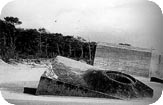|

I feel that in our society, where nothing seems to be certain or true, indifference and the wish to control are on the rise. The freedom fought for in the ‘60s and ‘70s seems to have slipped away. In fashion, for example, it is like in the 50ies: male dress like male and women like women. Androgeny (like Boy George it was Annie Lennox in the ‘80s) has disappeared. Another example is the emphasis on being successful. A growing number of people between their ‘30s and ‘50s live to work, seem to have no other goal than to become rich or famous, and lead a very unsociable life in which there is no time for friends and family. What worries me is that there doesn't seem to be a counter movement.
In my opinion, this reversion to obeying the definitions of categories is caused by the overexposure of virtual borders and the lack of the physical ones. To counterbalance this immaterial world composed of fast images, virtual borders, loose ideas, and transparent materials, I think it is necessary to add huge masses of solid material. My proposal is to build concrete, monolithic beacons as points of orientation, which at the same time function as accomodating shelters: hermetically closed bunkers in which one can disconnect from the flow of input for a moment.
These residencies can be built on locations where one transgresses a vanishing border: for example, in the no man's land inbetween two neutralized nationalborders. The concrete fortifications will serve as a monument for the borderland and its Zgodovina. Inside, one can experience what a border actually is: a tension between two opposite situations. While visiting these bunkers, one can reflect on the ambivalent face of truth.
Some remarks on the shape and the process of building the concrete bunker.
The shape
The bunker has no opening other than the entrance.
Its walls are thick and reinforced.
The thickness of the walls disturbs the receiving or sending out of any signals.
One can reach its inner space using an underground tunnel or a concrete revolving door.
The bunker has underfloor heating.
There is a bench to sit on.
Everything in the bunker is part of the same monolithic structure.
The construction process
The mold for the bunker is built on the site.
It is built in such a way that it can be poured at once.
The pouring is happening, attended by witnesses.1
After the pouring, vibrating machines are connected to the mold to make the air flow.
When the mold is removed, the bunker can begin functioning.
Amsterdam, 26 December 1999
|
|

